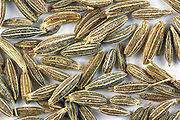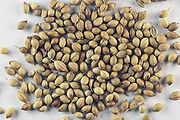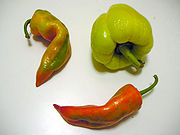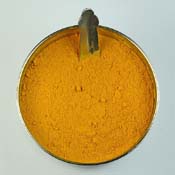SPICE Up Your Life!
SPICES: What are they?
Spices are dried seeds, fruit, root, bark, leaf or other vegetative
substances that are used as a food additive to flavor, color or preserve
food. Many can also be used as medicine. Spices differ from herbs in
that they are dried and then ground or grated into powder for use.
SPICES: Why are they special?
Spices are nutrient-rich foods that are high in vitamins (carotenoids,
vitamin C and vitamin B6) and minerals, especially iron, calcium,
magnesium, copper, manganese and potassium. Because of their
nutritious, culinary, and medicinal properties, spices have often been
used as means of exchange, i.e. currency.

CINNAMON is derived from the bark of a small evergreen tree
that is native to Sri Lanka. It one of the oldest, most popular and valued
spices known to man. It is mentioned in the Bible and was used in
ancient Egypt as a beverage flavoring, a medicine plus an embalming
agent. It was highly treasured and considered more precious than gold.
Cinnamon is mentioned in one of the earliest books on Chinese
botanical medicine, dated around 2,700 B.C. It became one of the most
relied upon spices in Medieval Europe. Due to its demand, cinnamon
became one of the first commodities traded regularly between the Near
East and Europe. Ceylon cinnamon is produced in Sri Lanka, India,
Madagascar, Brazil and the Caribbean, while cassia (cinnamon's
counterpart) is mainly produced in China, Vietnam and Indonesia.
Cinnamon is rated as one of the world's healthiest foods. It is
high in manganese, iron, dietary fiber, potassium, phosphorus, and
calcium. It contains three essential oils that initiate anti-clotting action,
anti-microbial activity, and control of blood sugar. Cinnamon also boosts
brain function, improves colon health, treats diarrhea and aids digestion,
protects against heart disease, lowers the respiratory rate of yeast,
treats toothache, fights bad breath, and is a traditional warming remedy
for colds and flu. It is also effective in treatment of Type 2 diabetes
mellitus and insulin resistance as well as oxidative stress, since it
contains high levels of antioxidants. One teaspoon of Cinnamon
contains as many antioxidants as a full cup of pomegranate juice
or 1/2 a cup of blueberries.
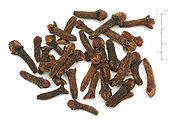
CLOVES are native to the Moluccas, formerly known as the Spice
Islands of Indonesia and have been consumed in Asia for more than
2,000 years. Chinese courtiers dating back to 200 BC would keep them
in their mouths in order to freshen their breath when addressing the
emperor so as to not offend him. Arab traders brought cloves to Europe
around the 4th century. However, cloves did not come into widespread
use until the Middle Ages when they became prized for their pungent
flavor that served to mask the taste of poorly preserved foods. While for
a long time, they were cultivated almost exclusively in Indonesia. Today
the leading clove-producing region is Zanzibar in Eastern Africa. In
addition to these two regions, cloves are also grown commercially in
the West Indies, Sri Lanka, Madagascar, India, Pemba and Brazil.
Cloves are the unopened pink flower buds of the evergreen clove tree.
The buds are picked by hand when they are pink and dried until they turn
brown in color. Their English name is actually derived from the Latin
word clavus, which means nail. Although cloves have a very hard
exterior, their flesh features an oily compound that is essential to their
nutritional and flavor profile. Cloves are known for their warm, sweet,
and aromatic taste that is popularly used in ginger bread and pumpkin
pie, but can is also a splendid addition to bean dishes and chili.
Cloves are a nutrient-dense food. They are an excellent source of
manganese, a very good source of dietary fiber, vitamin C and omega-3
fatty acids as well as a good source of calcium, magnesium, and
phytonutrients. Because they contain a variety of flavonoids, cloves
have anti-inflammatory and antioxidant properties. They are also used
in dentisty in conjunction with root canal therapy, temporary fillings, and
general gum pain. Clove oil is known to ease or eliminate toothaches,
abcesses and general mouth infections. Cloves is a common ingredient
in some over-the-counter sore throat sprays and mouth washes.
Whenever possible, buy whole cloves instead of clove powder since the
latter loses its flavor more quickly. Cloves should be kept in a tightly
sealed glass container in a cool, dark, and dry place. Ground cloves will
keep for about six months, while whole cloves will stay fresh for about
one year stored this way. Alternatively, you can extend their shelf life by
storing them in the refrigerator.
CUMIN is native to Egypt and has been cultivated in the Middle East,
India, China and Mediterranean countries for millennia. Cumin seeds
were highly honored as a culinary seasoning in both ancient Greek and
Roman kitchens.Throughout history, cumin has played an important role
as a food, medicine, embalming ingredient, cultural symbol, and a
cosmetic. During the Middle Ages in Europe, it was a recognized symbol
of love and fidelity. People carried cumin in their pockets when attending
wedding ceremonies, and married soldiers were sent off to war with a
loaf of cumin bread baked by their wives. Cumin was mentioned in the
Bible not only as a seasoning for soup and bread, but also as a currency
used to pay tithes to the priests.
Cumin has an aromatic, somewhat pungent taste that borders on citrus.
It became a popular, widely-used spice since its peppery flavor made it
a viable replacement for black pepper, a rare and often expensive
commodity.
Cumin is high in iron and manganese. Iron is an integral component of
hemoglobin that transports oxygen from the lungs to all body cells, and is
also part of key enzyme systems for energy production and metabolism.
Iron is also keeps the immune system healthy, aids in mestruation, is
important for growing children and adolescents, and pregnant or
lactating women. Cumin also has anti-carcinogenic properties, contains
potent free radical scavengers, enhances detoxification of the liver, and
aids the digestive system. Research shows that cumin may stimulate
the secretion of pancreatic enzymes that are necessary for proper
digestion and nutrient assimilation.
Cumin seeds resemble caraway seeds and belong to the same plant
family. Cumin is available both in its whole seed form and ground
into a powder. The seeds and powder should be kept in a tightly sealed
glass container in a cool, dark and dry place. Ground cumin will keep for
about six months, while the whole seeds will stay fresh for about one
year. Use cumin in salad dressings, soups, nut dishes, bean dishes,
dehydrated breads/crackers. A warm, soothing tea can be made by
boiling cumin seeds and letting them steep for 8-10 minutes.
CORIANDER, known as Chinese parsley, is an herb and spice.
Both leaves and seed are used as a seasoning. Fresh coriander
leaves, commonly known as cilantro, resemble Italian flat leaf parsley
which is not surprising, since cilantro and flat leaf parsley belong to the
same plant family. The fruit of the coriander plant contains two seeds
which, when dried, are the parts that are used as the dried spice. When
ripe, the seeds are yellowish-brown in color with longitudinal ridges.
They have a fragrant flavor that is reminiscent of both citrus peel and
sage.
Coriander is one of the world's oldest spices, dating back to 5,000 BC.
It is native to the Mediterranean and Middle Eastern regions and has
been known in Asian countries for thousands of years. Coriander was
cultivated in ancient Egypt and is recorded in the Old Testament. It was
used as a spice in both Greek and Roman cultures, the latter using it to
preserve meats and flavor breads. The early physicians, including
Hippocrates, used coriander for its medicinal properties, specifically as
an aromatic stimulant. The Russian Federation, India, Morocco, and
Holland are among the countries that commercially produce coriander
seeds. Coriander leaves (cilantro) are featured in the culinary traditions
of Latin American, Indian and Chinese cuisine.
Coriander is high in iron, magnesium, manganese, dietary fiber, and
phytonutrients. In addition to being an aromatic seasoning, the seeds
are a recognized healing spice. In parts of Europe, coriander has
traditionally been referred to as an "anti-diabetic" plant, since it helps
regulate blood sugar levels. Coriander has an exceptional phytonutrient
and flavinoid content, has anti-inflammatory and antibacterial properties
(that especially fight Salmonella) and is effective in lowering cholesterol.
Cilantro leaves can aid in cleansing heavy metals from the body.
Fresh coriander (cilantro) is highly perishable and should therefore
always be stored in the refrigerator, preferably with its roots still
attached. Place the roots in a glass of water and cover the leaves with
a loosely fitting plastic bag. If the roots have been removed, wrap the
coriander leaves in a damp cloth or paper towel and place them in a
plastic bag. Whole coriander will last up to one week, while coriander
leaves will last about three days. Cilantro can be frozen, either whole or
chopped, in airtight containers and thawed right before use.
Coriander seeds and coriander powder should be kept in an opaque,
tightly sealed glass container in a cool, dark and dry place. Ground
coriander will keep for about four to six months, while the whole seeds
will stay fresh for about one year. Coriander seeds can be easily ground
with a mortar and pestle. Soak in cold water for ten minutes and then
drain before grinding them to revive their fragrant aroma.
Coriander adds a fresh, fragrant aroma and taste to salads,
soups, smoothies, and entrees.
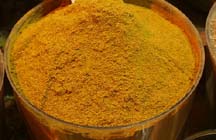
CURRY powder is a pungent often peppery mixture of spices,
commonly turmeric, cumin, coriander, fenugreek, and red pepper. The
composition of these aromatic spices is based on South Asian cuisine.
Curry powder was popularized during the nineteenth and twentieth
centuries through exports to Europe and North and South America. In
the western world curry powder mixtures have a fairly standardized
taste, though a great variety of spice mixtures are used in Indian cuisine,
including allspice, white pepper, ground mustard, ground ginger,
cinnamon, roasted cumin, cloves, nutmeg, mace, green cardamom
seeds or black cardamom pods, bay leaves, and coriander seeds.
The composition of curry powder, also known as masala, was developed
by the British in an effort to duplicate the taste of Indian cuisine at home.
Most commercial curry powders available in Britain, the U.S. and
Canada, rely heavily on ground turmeric which produces a very yellow
sauce. Lesser ingredients in these Western yellow curry powders are
often coriander, cumin, fenugreek, mustard, chili, black pepper and salt.
Curry is high in iron, calcium, potassium, vitamins A and K, magnesium,
and phosphorus. Traditionally the leaf is used in South Asia to treat
digestive problems, skin conditions, and diabetes. Some studies have
shown that ingredients in curry may help to prevent diseases like colon
cancer and Alzheimer's disease.
GINGER is the tuber (root) of the ginger plant. It belongs to
the same plant family as turmeric and cardamom. Ginger is highly
aromatic and pungent. It is native to southeastern Asia and has been
renown for millennia throughout the world. Ginger is mentioned in
ancient Chinese, Indian, and Middle Eastern writings and has long
been prized for its aromatic, culinary, and medicinal properties. After
the ancient Romans imported ginger from China almost two thousand
years ago, its popularity in Europe remained centered in the
Mediterranean region until the Middle Ages when its use spread
throughout other countries. Although it was a very expensive spice,
owing to the fact that it had to be imported from Asia, it was still in great
demand. In an attempt to make it more available, Spanish explorers
introduced ginger to the West Indies, Mexico and South America, and in
the 16th century, these areas began exporting the precious spice back
to Europe. Today, the top commercial producers of ginger include
Jamaica, India, Fiji, Indonesia, and Australia.
Ginger is rich in potassium, magnesium, copper, and Vitamin B6.
It is also high in phytonutrients and antioxidants. Historically, it is effective
in alleviating symptoms of gastrointestinal distress, especially gas and
spasms. Ginger possesses numerous therapeutic properties. It has
anti-vomiting action, thus it reduces and/or eliminates all symptoms
associated with motion sickness including dizziness, nausea, vomiting,
and cold sweating and is a safe and effective relief of nausea and
vomiting during pregnancy. Ginger's anti-inflammatory compounds are
known to aid rheumatoid arthritis and ease muscular discomfort and
swelling of various kinds. It also has been shown to be an anti-tumor
agent on cancer cells in the colon and ovaries. Ginger also boosts
the immune system by protecting the body from invading micro-
organisms such as ecoli, staph, fungi, and candida.
Because ginger is a concentrated, nutrient-dense food, it should be
used sparingly to receive its beneficial effects. Use it in the kitchen to
season foods of all kinds. Medicinally, use ginger to combat nausea by
making ginger tea. Steep one or two 1/2-inch slices (one 1/2-inch slice
equals 2/3 of an ounce) of fresh ginger in a cup of hot water settles the
stomach. For arthritis, some people have found relief consuming as little
as a 1/4-inch slice of fresh ginger cooked in food, although those who
consumed more ginger reported quicker and better relief.

PAPRIKA is a spice made from the grinding of dried fruits of
capsicum peppers, i.e. bell or chili peppers. The seasoning is used in
many cuisines to add color and flavor to dishes. Flavors vary from
country to country. Hungary is a major source of high-quality paprika, in
grades ranging from very sweet with a deep bright red color to rather
hot with a brownish orange color.
Paprika is high in Vitamin A and C, ion, potassium, calcium, and
antioxidants. Capsicum peppers used for paprika are unusually rich in
vitamin C and the vitamin C content is retained in paprika. Paprika
contains more vitamin C than lemon juice by weight. The antioxidant
content of paprika is about 10% of the level found in acai berries.
Paprika is a warming spice that when used in culinary dishes
adds a mild, peppery flavor. Because of its distinctive reddish
property, paprika is popularly used to garnish soups, salads, and
dips.
TURMERIC is native to Indonesia and southern India, where it has
been harvested for more than 5,000 years. It has served an important
role in many traditional cultures throughout the East. While Arab traders
introduced it into Europe in the 13th century, it has only recently become
popular in Western cultures. In medieval Europe, turmeric became
known as Indian Saffron, since it was widely used as an alternative to
the far more expensive saffron spice. Much of its recent popularity is
owed to the recent research that has highlighted its therapeutic
properties. The leading commercial producers of turmeric include
India, Indonesia, China, the Philippines, Taiwan, Haiti and Jamaica.
Turmeric comes from the root of the Curcuma longa plant and has a
tough, brown skin and a deep orange flesh. The roots (rhizomes) are
boiled for several hours and then dried in hot ovens, after which they
are ground into a deep orange-yellow powder. Its active ingredient is
curcumin, and it has an earthy, slightly bitter, hot peppery flavor along
with a mustardy smell.
Turmeric is high in manganese, iron, Vitamin B6, and dietary fiber.
It is a powerful food that has long been used in Chinese and Indian
medicines as an anti-inflammatory agent to treat a wide variety of
conditions, including flatulence, jaundice, menstrual difficulties, bloody
urine, hemorrhage, toothache, bruises, chest pain, and colic. Because
of its anti-inflammatory property, Turmeric is effective in treating bowel
diseases such as irritable bowel syndrome, colitis, and Crohn's disease.
As a powerful antioxidant, turmeric addresses joint problems and
combats cancers of all kinds. It improves liver function, lowers
cholesterol, protects against Alzeimer's and heart disease. It is also
an anti-bacterial agent and can be used as an antiseptic for cuts, burns,
and bruises. Turmeric has been shown to be an anti-venom for King
Cobra snake bites and can also be used to deter ants.
